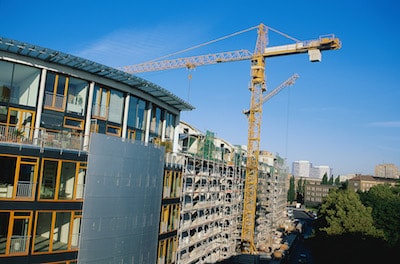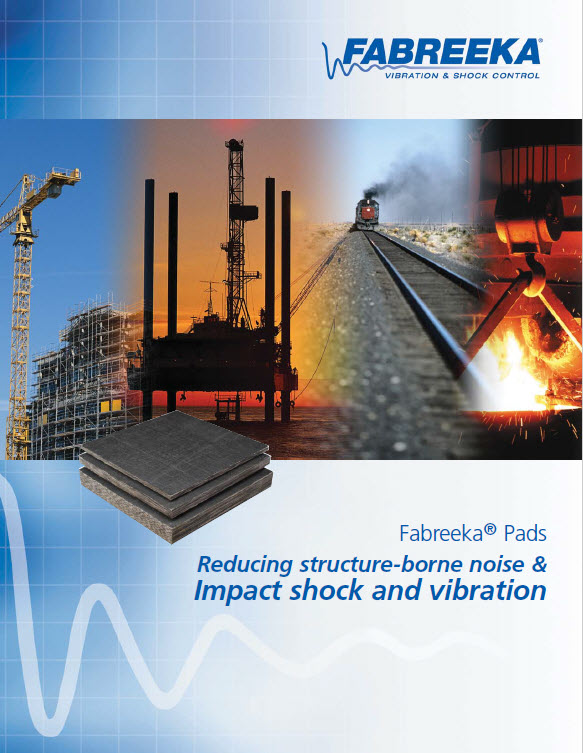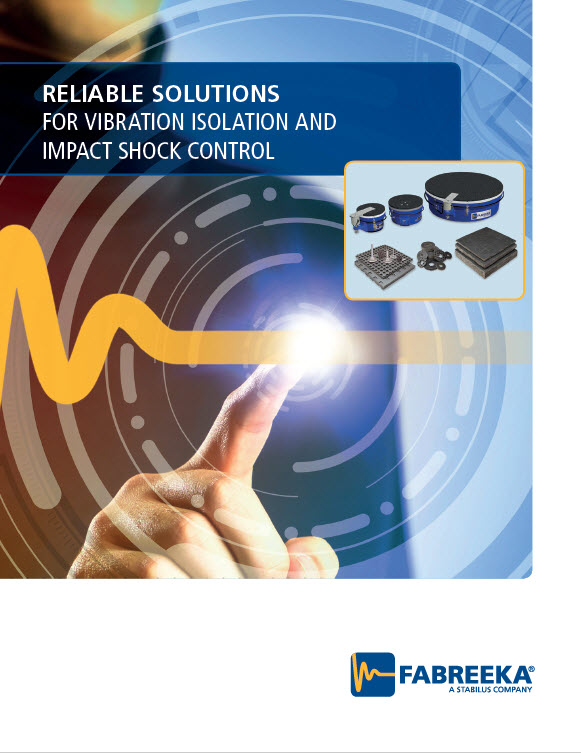



Bridges
Flexibility and movement are a necessity in bridge construction, whether a steel-bridge, a concrete highway overpass, or a bridge for a railroad. Without the ability to flex and move, the structural integrity of the bridge can be compromised, and eventually lead to failure. Fabreeka supplies bearing pads, both fixed and sliding, for bridges around the world. Fixed bearing pads, such as Fabreeka preformed fabric bearing pads and SA-47 random oriented fiber bearing pads are used on bridges to support uneven load and rotation on steel to steel or steel to concrete connections. These bearing pads, also known as bedding pads, provide uniform load distribution on highway and railroad bridges and reduce vibration by adding damping to steel structures. Fabreeka’s expansion bearings, or slide bearings, can be used on steel and precast concrete bridges. They offer a durable sliding surface with a low coefficient of friction to allow for thermal expansion and contraction in bridges to minimize structural stresses. Fabreeka type SBX expansion bearings include the company's own preformed fabric bearing pads to allow beam rotations created by loads. SBX expansion bearings also provide an even distribution of loads between members, and vibration is reduced by adding damping to steel structures. Fabreeka designs and manufactures custom expansion bearings to your specifications, including bearings with ultra-low coefficient of friction and bearings for high temperature applications.
Bridge Rail Pads
Fabreeka’s Bridge Rail pads have simplified the installation of railings as our SA-47 pad is supplied to the exact size and shape of the rail support contact area. This pad evenly distributes the loading and hold-down forces from the bolts by conforming to the irregularities of the surfaces in which it makes contact. Durable and dependable, Fabreeka bridge rail pads exhibit high compressive strength and a limited creep characteristic. These differentiating factors set them apart from the standard unreinforced neoprene pads, as well as making them a great alternative to epoxy and grout installations.
Lamp Post Pads
Fabreeka’s Lamp Post pads are an excellent and economical way to reduce shock and vibration induced by wind and traffic. Depending on the height of the pole and state specifications, pads made of either Fabreeka pad or SA-47 are supplied to the exact size, shape and bolt hole-pattern of the lamp post base. Lamp post pads help to evenly distribute loadings and adapt to any irregularities in the concrete mounting surfaces while providing damping to reduce post motion. Additionally, Fabreeka washers and bushings are utilized to completely isolate the lamp post from transmitted vibration.
Drain Trough
Fabreeka’s Drain Trough material is manufactured into a flexible water drainage system for use on bridges and overpasses. Designed for installation under the expansion joint fingers, these flexible troughs channel water into rigid down spouts and avoid water dripping on vehicles passing under bridges.
Buildings
For decades, Fabreeka International has been successful in vibration isolation and reducing structure-borne noise in buildings. With the combined effort of our expert engineering staff and an extensive selection of materials, we provide solutions to the many needs and challenges facing construction in the modern world. Our fixed bearing pads, whether Fabreeka or SA-47, support uneven load and rotation in steel to steel or steel to concrete connections, and provide even load distribution between members. Bearing pads reduce vibration on building floors, diminish structure-borne noise, and protect structural integrity by absorbing movement and deflection caused by movement. Fabreeka provides structural expansion bearings, or slide bearings, for numerous building applications. These expansion bearings allow thermal expansion of beams and other members, and they permit beam rotations caused by loads and have a low coefficient of friction which minimizes structural stresses. A building’s foundation can also require isolation from external vibrations such as traffic, trains, subway cars, or nearby construction. Fabreeka has several foundation isolation products to isolate the building base from these disturbing influences. Internal sources of structure-borne noise and vibration in buildings can come from mechanical rooms or elevator rail cars. Fabreeka reduces these noise and vibrations to provide a more serene environment for adjacent penthouses, offices, hotel rooms, or any other living spaces that could be adversely affected. Today’s engineers and architects are well aware of the benefits of energy efficiency. One way to enhance energy performance is by adding a Fabreeka-TIM structural thermal break, which is a load bearing thermal break that is used between flanged steel connections. This energy saving product maintains structural integrity while reducing energy transfer through the building envelope. This thermal bridging solution can be used on balconies and canopies, or other steel members protruding through the building envelope. For structural connections in compression, such as column bases, roof equipment, dunnage post support, and foundation connections, Fabreeka-TIM RF can be used to reduce thermal energy transfer. Additionally, Fabreeka-TIM series products can bring you a step closer to achieving LEED certification.
Towers
Steel stacks and towers have relatively low inherent structural damping; therefore, excessive top-of-stack deflection can happen at critical wind speeds due to vortex shedding. To keep deflection within acceptable parameters, damping must be added to the “stack-foundation-soil” system. One way to achieve this is with stack foundation dampers. A ring of Fabreeka preformed fabric pad is placed between the stack base plate and concrete foundation. Additionally, Fabreeka washers are installed between steel washers/plates under the anchor bolt nuts. Introducing damping to the structure minimizes amplification at resonance, therefore creating a more stable structure.
Fabreeka pad is the original preformed fabric reinforced, elastomeric pad developed in 1936. The properties of the Fabreeka cotton duck pad are exceptionally suited for impact shock control, vibration isolation and structure-borne noise insulation. Fabreeka pad can be used as a bearing pad as well as for isolation washers, bushings and OEM parts.
Fabreeka pad has been used for over 80 years for mounting heavy machinery where absorption of impact shock is required. Meeting or exceeding MIL-C-882 and MIL-E-5272 specifications, Fabreeka pad prevents cracking and flaking of concrete, eliminates the need for grout and prolongs the life of both machines and structures. Each preformed fabric pad made by Fabreeka is scientifically constructed to give years of service under the most severe operating conditions.
When considering vibration isolation, usually more than one disturbing frequency is present in a machine. As a general rule, an attempt should be made to isolate the frequency producing the largest vibration amplitude, while avoiding resonance with the other disturbing frequencies. Fabreeka’s fabric reinforced elastomeric material, with its resilience, minimal deflection and high strength, often serves as a more practical vibration isolator than softer materials.
Very effective, flexible and tough
Fabreeka’s part in isolating noise is one of reducing structure-borne noise. Fabreeka reduces mechanical vibrations which can be converted to air-borne noise. When isolating structure-borne noise, it is essential that all conductive paths of vibration be blocked. Therefore, Fabreeka pads, washers and bushings are required to completely break the metal-to-metal contact between the isolated unit and its support.
Fabreeka bearing pads were first used as a bridge bearing and are commonly used as a structural bearing element accommodating surface irregularity and rotations between load bearing faces. The preformed fabric pads can also be provided with a Teflon® surface for use in expansion bearings and pipe slides.
Depending upon the size and thickness, Fabreeka pad can ultimately withstand loads up to 10,000 psi. Normally, compressive stresses are designed not to exceed 2,000 psi to extend service life and reduce permanent set



What are the vibration isolation characteristics of Fabreeka pad?
Please refer to pages 8-15 in our Fabreeka Pad brochure.
Does all “cotton duck” reinforced pad material meet the MIL-C-882 specification?
No. The MIL-C-882 specification requires specific strength, deflection, density and permanent set properties.
How can I be sure the material I am buying meets the MIL-C-882 specification?
The supplier should supply a material certification stating that the material meets MIL-C-882. In addition, the deflection, creep and environmental test data should be provided or certified to.
What environmental tests are involved with the MIL-C-882 specification?
The pad material must pass several environmental tests per MIL-E-5272A.
What is creep?
Creep is the deformation of rubber is influenced by the length of time under stress. If the rubber is statically loaded to a given amount, as occurs for example by the support of a machine, then an elastic deformation takes place superseded after a longer period of time by creep. Creep behavior follows an exponential law and is concluded sometime afterward. If the isolator is released, then its shape returns elastically. High elastic grades show a small residual strain and minimal creep. With good elastic qualities, the creep lies between 5% and 10% of the total elastic strain.
What is permanent set?
Permanent set, or residual strain, takes place after prolonged loading and unloading of an isolator, and lies between 2% and 5% of its original thickness.
How is damping different than isolation/absorption?
The essential properties of an isolator are natural frequency (developed by the spring rate or stiffness) and an energy dissipating mechanism known as damping. In some types of isolators, the stiffness or natural frequency and damping properties are contained in a single element such as elastomers, cork, rubber mats, etc. Other types of isolators may have separate means of providing stiffness and damping as is the case with air springs (pneumatic isolators) and coil steel springs, which are relatively undamped until used in conjunction with auxiliary damping elements such as orifice flow restrictors and viscous dampers. The purpose of damping in an isolator is to reduce or dissipate energy as rapidly as possible. Damping is also beneficial in reducing vibration amplitudes at resonance. Resonance occurs when the natural frequency of the isolator coincides with the frequency of the source vibration.
The ideal isolator would have as little damping as possible in its isolation region as much as possible at the isolator’s natural frequency to reduce amplification at resonance. Damping, however, can also lead to a loss of isolation efficiency.
Can Fabreeka pad material act as an electrical insulator?
Fabreeka pad has a dielectric strength of 12,500 volts (210 volts/mil) and a resistivity of 8.5 x 10e9 ohm-cm. (Insulating material classification requires a resistivity greater than 10e5 ohm-cm.) As a comparison, natural rubber has a resistivity value of 10e15 ohm-cm. Fabreeka pad has a dielectric constant of 9.34, with a power factor of 0.201 and a loss index of 1.881. All of these values are for Fabreeka pad at a standard room conditions of 73°F (213°C) and 50% relative humidity.
How does static spring rate differ from dynamic spring rate?
The static deflection principle can only be used to determine the natural frequency of an isolator if the isolator under consideration is both linear and elastic. For example: rubber, felt, fiberglass and composite materials tend to be non-linear and exhibit a dynamic spring rate that differs from the static spring rate.
Similarly, the spring rate of a pneumatic isolator changes when undergoing a change from the static condition to a dynamic condition.
The natural frequency as calculated based on static load vs. deflection data will give inaccurate lower natural frequencies as compared to realistic experience during dynamic vibration.
Any isolator with a calculated natural frequency based on static deflection may not behave in the predicted way because the dynamic spring rate differs from the static spring rate. It is the dynamic natural frequency that has to be used in isolation calculations rather than the static natural frequency.
What are the thermal properties of Fabreeka material?
Thermal conductivity of Fabreeka material is expressed in power per unit of area divided by temperature gradient in degrees per unit of length. The Imperial units are 1.90 BTU INCH/HR/FT-SQ/Degrees F.
What are the manufacturing tolerances of the Fabreeka Pad?
Manufacturing tolerances vary by thickness and part geometry. Please contact Fabreeka’s Engineering department at 1-800-322-7352 or info@fabreeka.com to discuss the tolerances for your application.